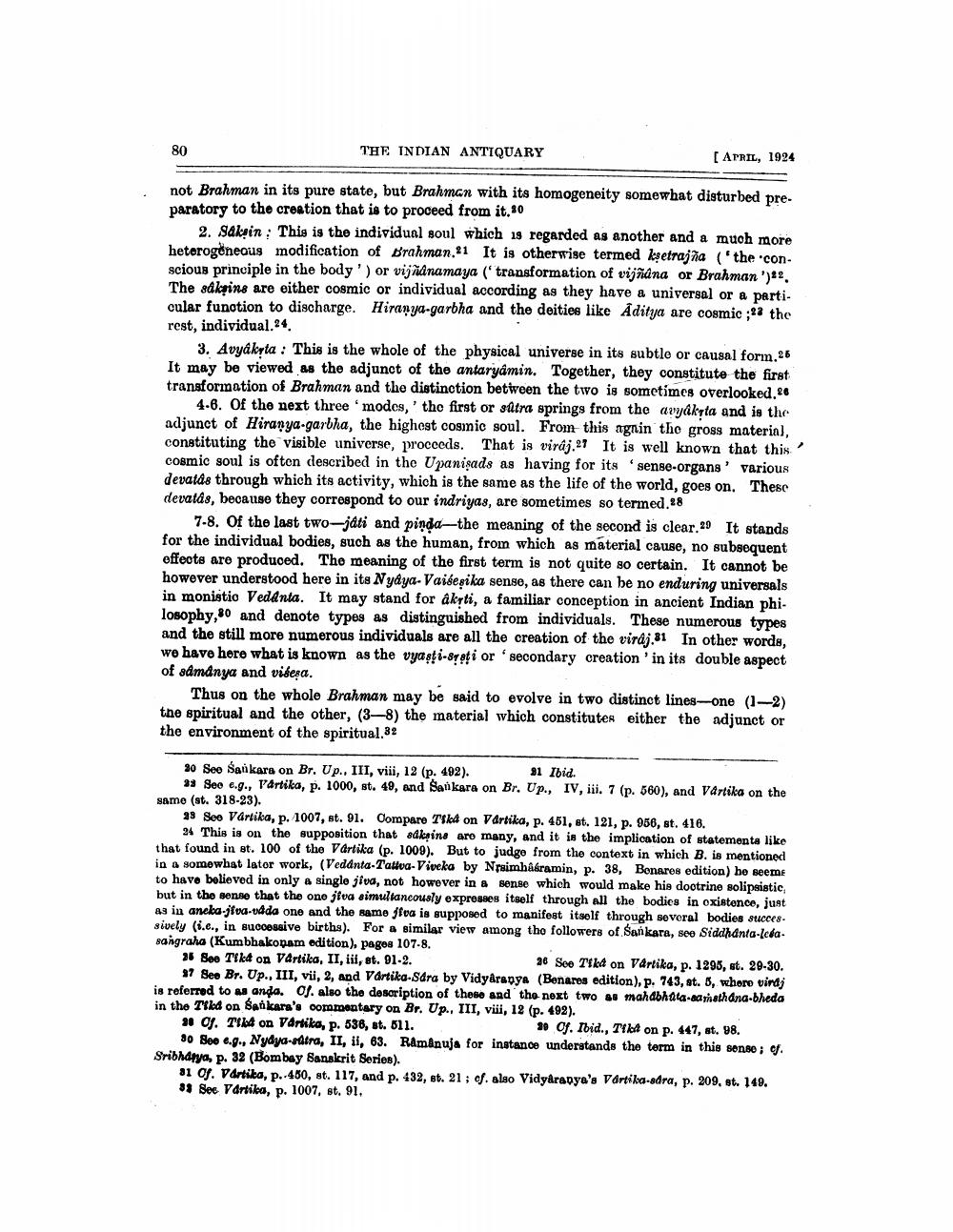________________
80
THE INDIAN ANTIQUARY
[APRIL, 1924
not Brahman in its pure state, but Brahman with its homogeneity somewhat disturbed preparatory to the creation that is to proceed from it. 20
2. Saksin : This is the individual soul which 19 regarded as another and a much more heterogeneous modification of Brahman.21 It is otherwise termed kşetrajña ('the .conscious principle in the body') or vijnanamaya (transformation of vijñana or Brahman')'.
The såkņins are either cosmic or individual according as they have a universal or a particular funotion to discharge. Hiranya-garbha and the deities like Aditya are cosmic ;22 the rest, individual.24.
3. Avyákyta : This is the whole of the physical universe in its subtle or causal form.26 It may be viewed as the adjunct of the antaryamin. Together, they constitute the first transformation of Brahman and the distinction between the two is sometimes overlooked.26
4.6. Of the next three modes,' the first or sutra springs from the avyákyta and is the adjunct of Hiranya-garbha, the highest cosmic soul. From this agnin the gross material, constituting the visible universe, proceeds. That is viráj.27 It is well known that this cosmic soul is often described in the Upanisads as having for its sense-organs' various devatas through which its activity, which is the same as the life of the world, goes on. These devatas, because they correspond to our indriyas, are sometimes so termed.28
7-8. Of the last two-jati and pinda-the meaning of the second is clear.29 It stands for the individual bodies, such as the human, from which as material cause, no subsequent effects are produced. The meaning of the first term is not quite so certain. It cannot be however understood here in its Nyaya-Vaibesika sense, as there can be no enduring universals in monistio Vedanta. It may stand for akrti, a familiar conception in ancient Indian philosophy,80 and denote types as distinguished from individuals. These numerous types and the still more numerous individuals are all the creation of the viraj.31 In other words, we have here what is known as the vyasti-stati or secondary creation ' in its double aspect of admdnya and višesa.
Thus on the whole Brahman may be said to evolve in two distinct lines-one (1-2) the spiritual and the other, (3—8) the material which constitutes either the adjunct or the environment of the spiritual.32
30 See Sankara on Br. Up., III, viii, 12 (p. 492). 21 Ibid.
39 Seo e.g., Vârtika, p. 1000, st. 49, and Sankara on Br. Up., IV, iii, 7 (p. 560), and Vartika on the same (st. 318-23).
23 Soo Vartika, p. 1007, st. 91. Compare Tsk on Vartika, p. 451, st. 121, p. 956, st. 416.
24 This is on the supposition that sdkrine are many, and it is the implication of statements like that found in st. 100 of the Vartika (p. 1009). But to judge from the context in which B. is mentioned in a somowhat lator work, (Vedanta-Tallva-Viveka by Nroimhabramin, p. 38, Bonares edition) he seeme to have believed in only a single jiva, not however in a sense which would make his doctrine solipsistic, but in the sense that the one jiva simultaneously expresses itself through all the bodies in oxistonce, just as in aneka-jtua-udda one and the name fua is supposed to manifest itself through several bodies sticces. sively (6.c., in successive births). For a similar view among the followers of Sankara, see Siddhanta-leka. sangraha (Kumbhakopam edition), pages 107-8. 25 See Tik4 on VArtika, II, iii, st. 91-2.
26 See Met on Vârtika, p. 1295, st. 29-30. 37 See Br. Up., III, vil, 2, and Vartika-Sdra by Vidyaranya (Benares edition), p. 743, st. 8, where vindj is referred to as anda. Of. also the description of these and the next two as mahabhata-sanathana-bheda in the Tiked on Sankara's commentary on Br. Up., III, viii, 12 (p. 492). u of. Tilt on Vårtika, p. 538, st. 511.
30 Of. Ibid., Thon p. 447, st. 98. 30 Soo e.g., Nydya-editra, II, II, 63. Ramanuja for instance understands the term in this songe ; cf. Sribharya, p. 32 (Bombay Sanskrit Series).
31 of. Vartika, p. 460, st. 117, and p. 432, st. 21; cf. also Vidydranya's Vartika-adra, p. 209, st. 149. 33 See Vartika, p. 1007, st. 91.




